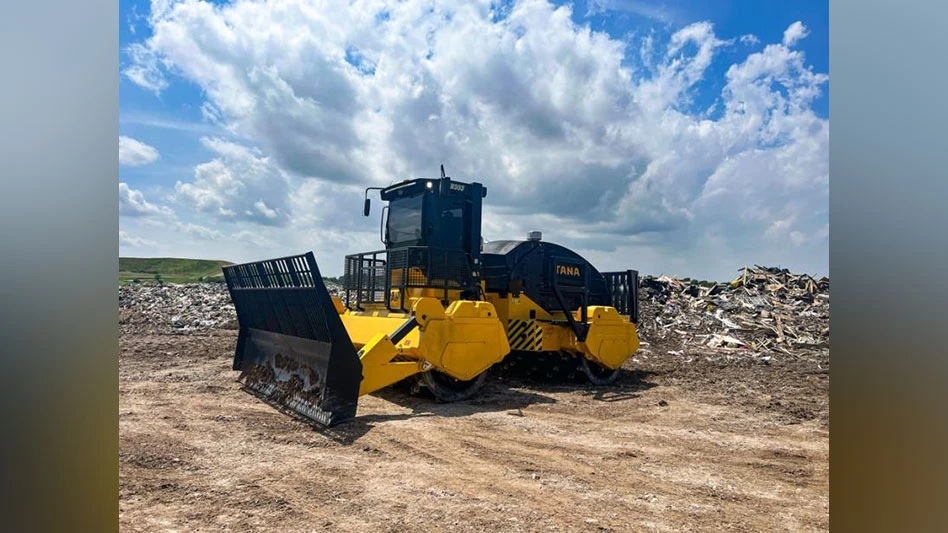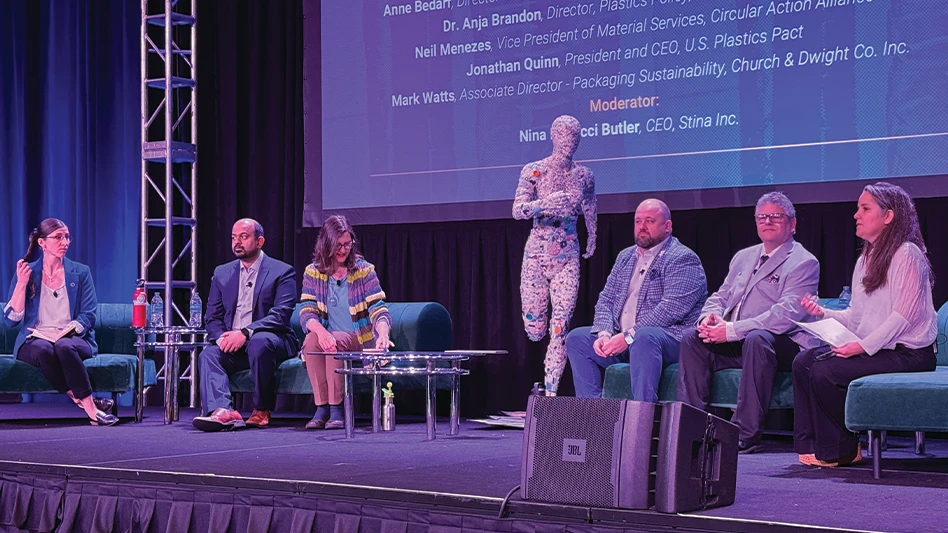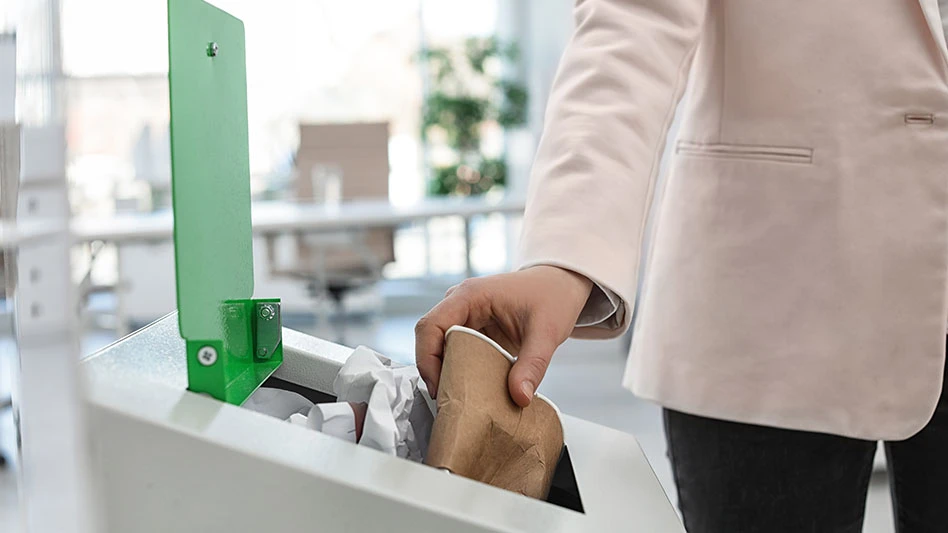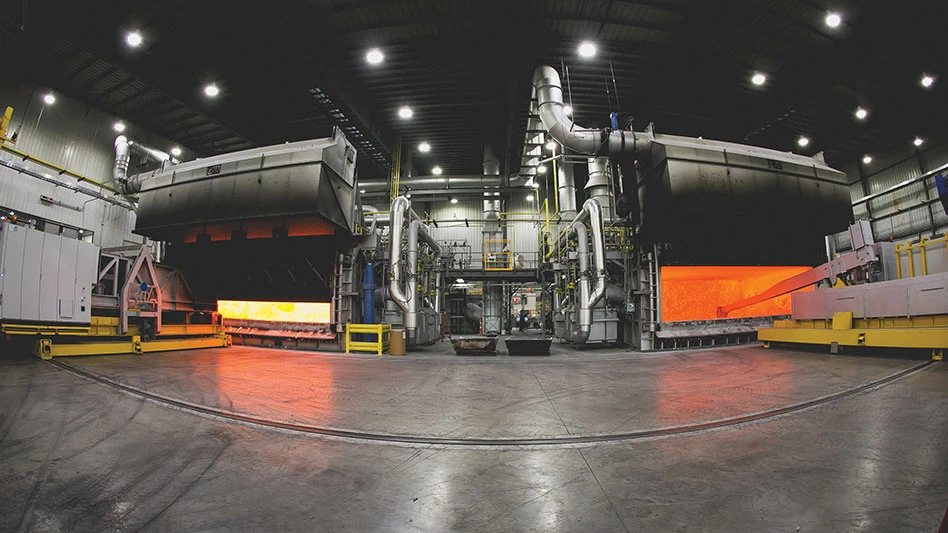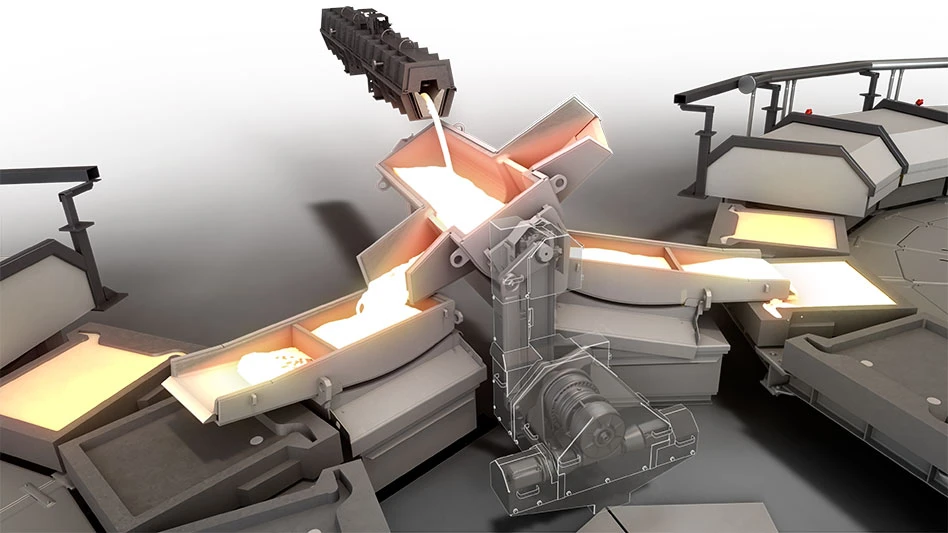To earn the title “king of the paper jungle,” a facility would have to be able to devour enormous volumes of paper, pouncing efficiently upon every new truckload brought in, baling it and sending it away, and still be ready to come back on the prowl for new challenges the next day.
At the front end, the key to success is being able to move trucks in quickly, have them dump their loads, and get them back on the road. At the back end, the secret is to keep the baler working full-time without any major delays caused by handling different types of material. Sorting dirty paper, mixed grades of office paper and corrugated, and handling the material in an effective, cost-efficient manner has been an ongoing challenge for MRFs everywhere.
However, the Weyerhaeuser Recycling Facility in Itasca, Ill.—near Chicago—was designed from the ground up as a state-of-the-art facility to handle paper. It is one of 26 sites that the company operates nationwide.
“We are well set up to handle what has been a difficult stream for the typical MRF,” says Victor R. Trautwein, who is the area manager of the facility. One major advantage was the ability to design from the ground up.
Part of the reason for their success is the Bulk Handling System (BHS) mechanical sorter used in the operation today. The addition of the sorting equipment has allowed Weyerhaeuser to expand the amount of material the operation can handle by from 30% to 50%, Trautwein calculates.
Prior to having the sorting equipment, they kept large piles of material at the front of the plant. It was cleaned by hand. This equipment allows them to clean up the OCC and commercial mixed paper immediately. Not only does this help Weyerhaeuser, but it also benefits suppliers. Turn-around time for haulers—from arriving at the scale to checking out over the scale—generally is under 15 minutes. In many cases, it is less than ten minutes.
“We consider ourselves a neutral outlet for waste hauling companies,” Trautwein says, noting that a real obstacle to the industry is getting material to ship that is as clean as corrugated from industrial accounts. “We believe we add value to our waste hauling customers by accepting a wide range of paper grades from commercial mix to very clean office paper and OCC, rebating competitively, and quickly turning around incoming trucks. We realize that saving these customers half an hour of driving time on each truck several times a day keeps their utilization high on these expensive assets and lowers their labor costs on a per ton basis. No one wants to pay a driver $20 per hour to sit in a parking lot.”
The Itasca operation started as a greenfield operation in November, 1995. In the two-and-a-half years that it has been operational, it has ramped up to well over 200 tons per day. Almost the entire volume of material comes from commercial sources. “At this point in time, we don’t run any residential recycled material through the operation,” Trautwein says.
The plant was converted from being a diaper plant. At the same time it was opening the Itasca facility, Weyerhaeuser was starting a new mill in Cedar Rapids, Iowa that was destined to be the largest user of recycled corrugated in the U.S. This mill makes recycled linerboard and corrugating medium. The plan has been for much of the Itasca material to be shipped to Iowa.
The focus of the Itasca facility is post-consumer office paper and corrugated. Overall, they handle 20 to 30 grades of paper and aluminum. “Corrugated and office paper is where our growth has come from. It’s where we believe additional recovery is possible in this part of the country. With landfill costs low and strong export markets harder to reach, recovery levels for OCC and office paper have lagged behind other areas of the country. We believe that a large opportunity exists to ‘harvest’ more of these grades from cities like Chicago. That’s why we are here,” Trautwein says.
Weyerhaeuser has tamed the recovery tiger. The plant has grown dramatically in its first two plus years of operation. Trautwein believes it is the most rapid startup in the company’s history. Additionally, they have been able to do it safely. With about 25 full-time workers now on board, to date there has been no OSHA-recordable incident at the plant.
As the volume grows, so has the workforce. The company is replacing temporary workers with full-time personnel as they find the right people and as throughput increases.
FACILITY SETUP
The primary operating space is a 40,000-square foot floor. A rail dock sits at the back of the facility and there is a 20,000 square-foot inventory room that allows them to load three rail cars at once.
The facility has two ground-level receiving doors that open to the receiving floor. They particularly like to have the OCC, and also some of the office paper, delivered through the receiving doors. “We can take a range of quality from pure OCC down to a commercial mix,” Trautwein says. “We can take material which has little value to negative value and make quality paper grades from it.” Not only does less material end up in the landfill, but the plant also converts what may have historically sold as low-grade mix to higher quality grades preferred by mill customers.
“This is good for the stability of our industry,” says Trautwein. “We don’t need more mixed paper.”
If things are purring along nicely and the OCC is clean, it is immediately pushed back to the OCC pile. It is tipped onto the floor in the receiving area and then pushed back into the large OCC pile. If the OCC material is a commercial mix, it is pushed on to the conveyor. Mixed material runs over a Bulk Handling Systems OCC SeparatorTM and is cleaned up mechanically. The OCC goes over the top of the system and other fiber drops below. The result is clean OCC and other fiber. High-grade office material is kept in a separate pile. It goes up the incline over the U’s (U-shaped holding bins, often made of concrete or cinder block), and gets sorted to spec.
A six-bay truck dock, at the lower left, is also available. Source-separated material generally comes in one of six dock-level truck doors. The doors, along with a three-car rail siding, also are used for shipping.
Inbound material will be dumped to the U’s and pushed to the conveyor when they are ready to run it. They may find hard white, manifold white or manifold color ledger in a lot. These are materials that generally do not require extensive cleaning or sorting.
AUTOMATIC SORTING
In June, 1997 Weyerhaeuser received a $250,000 grant from the State of Illinois to install the sorting equipment. While the company had been moving in that direction, the grant was what it took to put the project over the top. The grant allowed them to try the technology and prove its worth. “It made the decision possible,” Trautwein says.
In November they put in the high-grade sort line. The following February saw the BHS OCC Separator sort go in. Prior to that time, all that was used was a long conveyor and a series of U’s. A Presona baler sits at the end of the long conveyor. To the left of the conveyor is a series of seven U’s that are actually walls under the sort platform that form bunkers. Overhead sits a sort system. A pit, two incline conveyors and a sorting platform were added above the U’s. Material is pulled off of the sort system and dropped through chutes to the bunkers. When the time comes to run a particular grade of material, a loader is brought around on the left side of the U and the paper is pushed through the U onto the long conveyor to the belt. Material destined for the screen sorter typically comes in the door in a 40-yard compactor box from a waste hauler. It will contain three to five tons of material. The truck will back inside, under the roof. The material will be dropped in the Mixed OCC area. The bulk receiver runs a loader, and will grade the paper from 100% OCC down to commercial mix. Clean OCC is pushed back to an area beyond the OCC screen so it can be easily fed on to the main baler conveyor.
If the material has other fibers or is a commercial mix it gets pushed onto the conveyor. The material rides up the conveyor and over the conveyor. This series of rotating disks agitates the material. The idea is to sort large and rigid OCC and send it over the top of the sorter. Anything smaller and more flexible will go through the screens and drop down. The corrugated goes to the clean OCC pile. The whole right side of the building is set aside for OCC in a rather large area. The other fiber falls through to a concrete bunker on the floor. That material, largely made of office fiber and perhaps some newspaper, is sortable material. That material is grabbed with a grapple on a Bobcat or other loader and pulled across to be sorted on the high-grade system.
The system has trouble handling loads with a lot of chipboard or small pieces of corrugated. The little pieces do not flow well over the top and tend to fall through. Such lots will be sent out as mixed paper. While they still are learning which material makes sense to sort, they have found that—in general—it makes sense to re-sort material which falls through the screen once. That material is pulled over to a storage area to the right of the wall in front of the offices. It is stored behind the pit for the Over-U system.
They do distinguish between the types of office paper, one pile being reserved for cleaner material and the other for dirtier material. The various grades are kept separated by a low, concrete-block wall. Paper that falls through the OCC Separator is dragged over to the office pile to go through the high-grade system.
OCC and commercial mix no longer are sorted by hand into the baler. It is sorted into clean material that can be baled efficiently and into office material that is cleaned up over a sort line. This allows them to divorce the sorting and cleaning process from the baling process. The goal is to never have to slow the baler to run the material into the quality the mills expect.
“From the mill’s point of view, the sorting equipment makes sure we produce a product that meets their specification,” Trautwein says. “We basically have mechanical equipment to make sure our corrugated is high quality.”
Mill buyers hate downtime on their machinery. Downtime means they are wasting money. Any mill operator will cringe when off-spec material comes into the plant. It can result in expensive downtime in the mill, which can more than offset any price advantage from buying recycled material.
Better quality material sent from the recycler to the mill results in better quality material out of the mill. “That is worth something to them,” Trautwein says. On the corrugated side of the operation, material is mechanically cleaned, the first step in producing a high quality fiber for buyers.
On the office paper side, all material shipped has gone through the sorter first. That helps them guarantee quality to the mill customers.
Typically, they will run all of the U’s empty at one run. That may take about two hours on the baler. Then they will go back to running corrugated which has been accumulating while the other material is being baled. It may be stored in cages or carts until ready to run. As soon as the U’s are cleaned out, the baler is switched to handling corrugated for another two hours.
“We are never slowing down the baler to clean material going into the baler. The sorting equipment has dramatically increased our baling capacity,” Trautwein says. Prior to having the equipment, all sorting and cleaning was done on the way to the baler—a typical scene at many paper handlers.
At any plant (including Itasca prior to installing the separator), material that is not source separated can cause the baling operation to slow down. The potential result is a big backlog at the front of the plant and huge piles of off-quality material.
Since the material is cleaned up almost immediately after it comes into the plant, they are not dealing with 50-ton piles of mixed corrugated that has to be separated. The tipping floor remains clear all day. “That’s why we don’t have waiting time at all for trucks coming in here,” Trautwein says.
NO CURBSIDE MATERIAL
The Itasca location is somewhat unique in not handling residential material. “In Chicago, there are about 60 companies who recycle paper. The residential area represents a whole different set of customers,” Trautwein says. “We thought our opportunity was better with a focus on OCC and office paper, where we have great mill take-away and can give good value to our customers. A lot of our strategic third-party customers are looking for post-consumer de-inked material.
Sponsored Content
Still relying on manual sorters?
Let AI do the heavy lifting. Waste Robotics delivers reliable, high-performance robots tailored for complex waste streams. They require minimal maintenance, are easy to operate, and are designed to boost your recovery rates. Smarter sorting starts with the right partner. Waste Expo Booth #1969 & REMA #2843
Click here to see our robots in action!“We don’t want to try to be everything to everyone. So we have not focused on the residential marketplace. And that’s been a successful formula for us,” he adds. “We try hard to bring value to our supply and mill customers.”
That does seem to be the case, given the plant’s growth record over the past couple of years. At present, about half of the material processed through Itasca is sent to the Cedar Rapids operation. The rest goes to third-party customers. He would like to see the plant handling 7,000 to 8,000 tons of material per month in its current form.
There is an additional 100,000 square feet of building area (currently leased out) which could be used for expansion. This would allow them to add a baler, or at least add more space to receive
BETTER EACH MONTH
“We get better each month in making the sorting equipment work,” Trautwein says. “It has been extremely beneficial for the efficiency of our plant and has benefited our mill and our supply customers. It has allowed us to dramatically increase the capacity of our plant at a time when we were starting to run out. More importantly, it has allowed us to improve turn-around time for our delivered customers and guarantee quality to our mill customers. We did okay before, now we are even better.”
With its efficient design, easy unloading, quick mechanized sorting, and smooth operating procedure, there is little doubt that this plant deserves the title “pick of the litter.”
The author is an environmental writer and Recycling Today contributing editor based in Strongsville, Ohio.
Separating Paper and Glass
Mixed paper is not the only challenge facing MRFs trying to produce marketable loads for mills. Glass in paper can be a worse problem for buyers than loads with mixed paper grades.
However, when a recycler in Quebec, Canada faced this problem, the company approached Andela Tool and Machine, Bedford, N.Y. with the challenge of removing glass from light cardboard, printed stock, newsprint and office paper. As a field test, Andela prepared loads of sorted paper seeded with levels of glass ranging from 1% to 5%.
By using a flexible impactor on the glass-paper mix, they were able to break down the glass into small pieces but not destroy the paper fraction of the load. They ran the glass through their Commingled Recycling System.
The paper-glass mix was run over a trommel screen with three-fourths and 1.5-inch spacings, which may be a bit undersized for this type of application. A 2.5-inch opening in a perforated metal six-foot by 20-foot screen would be better. The result was still good: broken glass was screened out and the paper moved down the line.
According to Bob Yaciuk, Andela’s marketing manager, their weighed and measured samples found less than three-tenths of one percent glass in the paper after running the material—including the items designed to defeat the system.
Yaciuk says an AGB-3 breaker with a throat opening of 28-by-54 inches, designed to handle 4,000 to 6,000 cubic feet of recycled paper per hour, is optimum for such a situation.
Get curated news on YOUR industry.
Enter your email to receive our newsletters.

Explore the June 1998 Issue
Check out more from this issue and find your next story to read.
Latest from Recycling Today
- Fenix Parts acquires Assured Auto Parts
- PTR appoints new VP of independent hauler sales
- Updated: Grede to close Alabama foundry
- Leadpoint VP of recycling retires
- Study looks at potential impact of chemical recycling on global plastic pollution
- Foreign Pollution Fee Act addresses unfair trade practices of nonmarket economies
- GFL opens new MRF in Edmonton, Alberta
- MTM Critical Metals secures supply agreement with Dynamic Lifecycle Innovations



